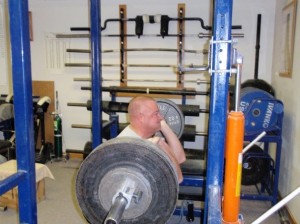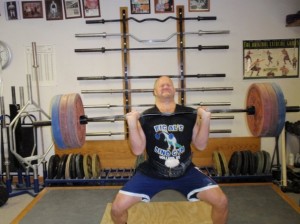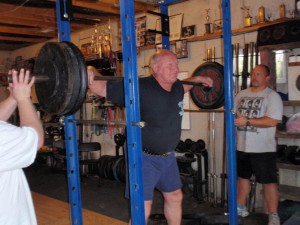Bars, Bars, and MORE Bars!
by Thom Van Vleck

Al doing front squats, his favorite lift! But try to ignore him, what I really want you to notice is the wide variety of bars on the Dino Gym wall!
Ok, if you lift weights regularly I’m sure you have noticed there are a lot of bars out there! Yesterday, Al pointed out what’s “legal” in the USAWA and how that rule has changed to allow some wiggle room. He wrote that article in response to my use of the over sized “John Ware” bar used at the OTSM Championships. I think I inadvertently opened a can of worms for Al using that bar. I, for one, appreciate the wiggle room. Here’s why:
Back in the day, all bars were assumed to be made for competition so they were all made to exact specifications. I remember sitting down with my Uncle Wayne Jackson as he ordered a new York 400lb Olympic set in 1977 (I still have it!). Back then, you had few suppliers to order from……then came the fitness craze and people started making bars for training, not competition. What’s the one thing that can end the life of a bar? Getting bent! How do you make a cheap bar last longer? Make it thicker and out of harder steel, so you end up with these bars that are thicker and of hardened steel that won’t “whip” like a high quality Oly bar. When you walk into my gym you will see the “gun rack” of bars and at first glance, they all look alike. But look closely and you’ll see all kinds of subtle variations. I’ll blame China, too. Even Eleiko, the “Cadillac” of barbells, now has their bars forged in China, then assembled in Sweden. I had a York bar that had “York, U.S.A” on it….made in China…but assembled in the USA so I guess they get around the loophole of not mentioning “China” on the bar. I’ll blame China because I don’t think they worry too much about “exactness”. They don’t care if it’s “legal”, they just crank out a product and if it’s close, then it’s all good to them.
I have about 15 or so bars (I don’t know exactly how many because I have so much of my stuff out on “loan” I’ve lost count. But let’s just say I have a wide variety of bars (but not as many as the Dino Gym) and when you look closely at these bars there are all kinds of subtle…and not so subtle differences. There are also many variations in the type of steel used. The best kind of steel for a bar will bend and good steel will bend and then snap back into it’s original shape. Hardened Steel will not bend and will tend to snap if you force it to bend or it will bend and stay that way. You can even have good and bad batches of steel that are intended to be the same. So, two bars that are “Exactly” the same upon visual inspection, maybe even made by the same company, may have very different characteristics. Companies today will “contract” out jobs to factories in China. That contract may be bid out after each order and a different company will supply the bar each time resulting in all kinds of variations.

Ok, just ignore he ugly guy doing the Continental to the Shoulders and focus on the bars on the wall! More bars in Al's gym!
Finally, it’s my contention the original size of an Olympic bar was developed for the average sized man. I am 6’3″ and my wing span is 6’9″. It is very difficult for me to get under a “regulation” bar and not bind up. John Ware was the same way so he had that bar we used in the 2011 OTSM Championships custom made for him. I know there are some issues with having the weights further away from the center of gravity and that can create more “whip” and help with certain lifts…but it’s easier for the shorter guy to adapt to a longer bar than the taller guy to adapt to a shorter bar.

Again....try not to focus on the ugly guys...and notice the bars leaning against the wall in the background! The JWC has it's fair share of bars! (btw...that's Dean Ross hitting a Anderson Squat at the OTSM in the JWC Training Hall!)
So, the moral of my story? There are a lot of variations out there on the “standard” Olympic bar. Some will bend, some will have good whip. I have 4 made by York and there are differences in width INSIDE the collars and there should NOT BE as these are regulation bars. We need a little play so that we can allow for more bars to be used. Weightlifting for fitness is a growing craze, but lifting as a sport is DYING! Today’s generation is not the sticklers for details like Baby boomers who were raised by the WWII generation where almost everyone had served in the military and picked up on that “attention to detail”. Today’s younger guys just want to lift more weight and they don’t like rules that make no sense to them. Rules are made to make things more fair, not the other way around. So, thanks to the USAWA for loosening up the rules on the dimensions of the bars but keeping the spirit of fairness by having rules that keeps the lifting true and comparable from contest to contest! I think it will be good for our sport!